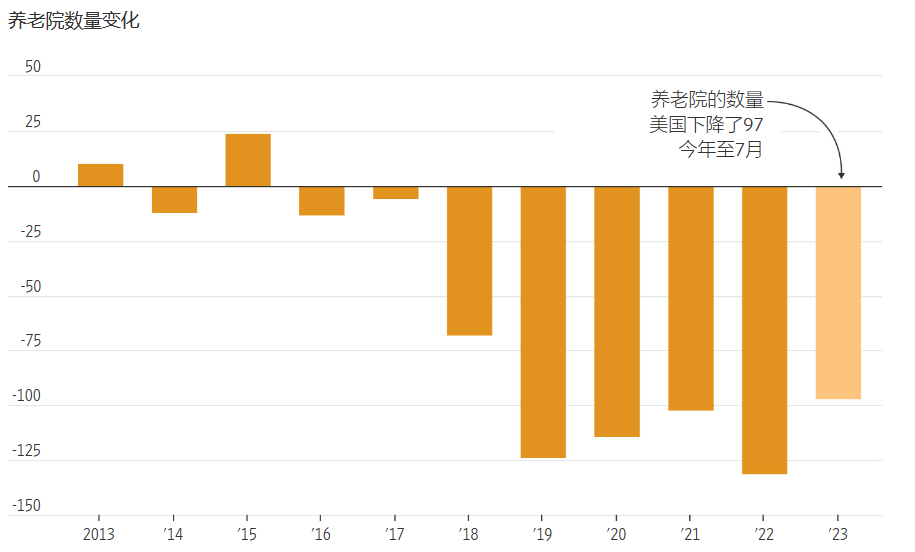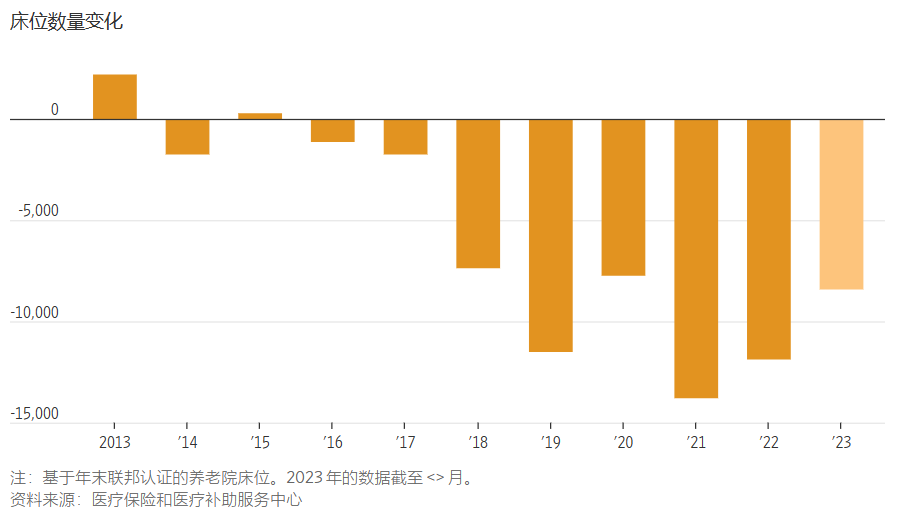 美国正在迅速消失的养老院,病人要在医院等上几个月才能等到养老院的床位
美国正在迅速消失的养老院,病人要在医院等上几个月才能等到养老院的床位
The Upheaval at America’s Disappearing Nursing Homes, in Charts
译文简介
美国人养老成问题
正文翻译

America’s nursing homes are fading away.
The U.S. has at least 600 fewer nursing homes than it did six years ago, according to a Wall Street Journal analysis of federal data. More senior care is happening at home, and the Covid-19 pandemic caused many families to shun nursing homes while draining workers from an already short-staffed industry.
The result? Frail elderly patients are stuck in hospitals, a dangerous place for seniors, waiting for somewhere to go—sometimes for months. Beds are disappearing while the need for senior care is growing. The American population 65 and older is expected to swell from 56 million in 2020 to 81 million by 2040.
美国的养老院正在逐渐消失。
根据《华尔街日报》对联邦数据的分析显示,与六年前相比,美国的养老院至少减少了600家。越来越多的老年人在家里进行护理,新冠肺炎大流行导致许多家庭避开养老院,同时也让这个本已人手短缺的行业中的工人流失。
结果是?体弱的老年病人被困在医院里,这对老年人来说是一个危险的地方,他们在等待着一个去处,有时甚至需要等待数月之久。病床正在消失,而对老年护理的需求却在增长。预计到2040年,美国65岁及以上的人口将从2020年的5600万增至8100万。
Even before the industry started to shrink noticeably, it was effectively contracting. Though fewer people tend to live in counties without nursing homes, those counties tend to have more elderly residents than average. For people who need comprehensive care, closures can mean disruptive moves or ending up far from loved ones.
Data show capacity in the nursing-home industry has lagged behind growth in the ranks of older Americans for many years. By 2018, the decline accelerated as nursing-home beds steadily disappeared.
甚至在该行业开始明显萎缩之前,事实上它就已经在收缩。尽管没有养老院的县的人口往往较少,但这些县的老年居民往往比平均水平更多。对于需要全面护理的人来说,关闭可能意味着被迫搬迁或者最终远离亲人。
数据显示,养老院行业的容纳能力多年来一直落后于美国老年人的增长。到2018年,随着养老院床位的稳步消失,下降速度加快。
Data show capacity in the nursing-home industry has lagged behind growth in the ranks of older Americans for many years. By 2018, the decline accelerated as nursing-home beds steadily disappeared.
甚至在该行业开始明显萎缩之前,事实上它就已经在收缩。尽管没有养老院的县的人口往往较少,但这些县的老年居民往往比平均水平更多。对于需要全面护理的人来说,关闭可能意味着被迫搬迁或者最终远离亲人。
数据显示,养老院行业的容纳能力多年来一直落后于美国老年人的增长。到2018年,随着养老院床位的稳步消失,下降速度加快。

The shrinkage was decades in the making. Most older people would prefer to stay in their homes and more Medicaid spending on long-term care has gone to home- and community-based services rather than institutions such as nursing homes since 2013. Those forces contributed to a net loss in nursing-home beds that has hit almost every state.
这种萎缩已经酝酿了数十年。大多数老年人更愿意留在自己的家中,自2013年以来,用于长期护理的多数医疗补助开支已流向家庭和社区服务,而不是养老院等机构。这些因素导致养老院床位净减少,几乎影响了每个州。
In the pandemic’s first year, before the introduction of Covid-19 vaccines, the virus swept through nursing homes with deadly results. More than 167,800 nursing-home residents died from Covid-19, and many of the facilities’ employees also died from the virus. Staffing levels have recovered at hospitals since the worst of the pandemic but not at nursing homes.
在大流行的第一年,在引入新冠肺炎疫苗之前,这种病毒席卷了养老院,并且造成了致命的后果。超过16.78万名养老院居民死于新冠肺炎,许多养老院员工也死于该病毒。自疫情最严重时期以来,医院的人员配备水平已经恢复,但养老院的人员配备水平尚未恢复。
原创翻译:龙腾网 https://www.ltaaa.cn 转载请注明出处
在大流行的第一年,在引入新冠肺炎疫苗之前,这种病毒席卷了养老院,并且造成了致命的后果。超过16.78万名养老院居民死于新冠肺炎,许多养老院员工也死于该病毒。自疫情最严重时期以来,医院的人员配备水平已经恢复,但养老院的人员配备水平尚未恢复。
原创翻译:龙腾网 https://www.ltaaa.cn 转载请注明出处
In Massachusetts, where bed losses are among the steepest, recent state hospital-association surveys show 563 patients a month, on average, couldn’t leave hospitals for nursing homes when the patients were ready. Hundreds of such patients have spent at least a month in hospitals, with the longest waits stretching for six months or longer.
在床位流失最严重的马萨诸塞州,最近的州医院协会调查显示,平均每月有 563 名患者在准备好后无法离开医院前往疗养院。 数百名此类患者已经在医院呆了至少一个月,最长的等待时间长达六个月或更长时间。
在床位流失最严重的马萨诸塞州,最近的州医院协会调查显示,平均每月有 563 名患者在准备好后无法离开医院前往疗养院。 数百名此类患者已经在医院呆了至少一个月,最长的等待时间长达六个月或更长时间。
Similar delays at hospitals across the U.S. are adding to emergency-department backlogs that reached records last year, according to data from the Emergency Department Benchmarking Alliance. Half of patients ready to move from an emergency department to a hospital bed waited at least 2½ hours in 2022. Such delays raise risks of harmful complications for patients.
根据急诊科基准联盟的数据,美国各地医院的类似延误正在加剧急诊科的积压,去年急诊科的积压已达到创纪录水平。2022年,准备从急诊科转到医院病床的患者中,有一半至少要等待两个半小时。这种延误增加了患者出现有害并发症的风险。
根据急诊科基准联盟的数据,美国各地医院的类似延误正在加剧急诊科的积压,去年急诊科的积压已达到创纪录水平。2022年,准备从急诊科转到医院病床的患者中,有一半至少要等待两个半小时。这种延误增加了患者出现有害并发症的风险。
New safety regulations could put more pressure on nursing-home operators to significantly increase hiring. The Biden administration has said it plans to set a minimum time that nursing-home staffers must spend with each resident. About seven out of 10 nursing homes don’t have enough nursing employees to dedicate four hours a day to each resident, according to KFF, a health-policy nonprofit. Federal research years ago deemed 4.1 nursing hours to be safe for residents.
新的安全法规可能会增加对养老院经营者的压力,要求它们大幅增加雇佣人数。拜登政府表示计划规定养老院员工必须与每位居民相处的最短时间。根据健康政策非营利组织KFF的数据,约七成养老院没有足够的护理员工每天为每位居民提供四小时的护理。几年前的联邦研究认为,4.1小时的护理时间对居民来说是安全的。
新的安全法规可能会增加对养老院经营者的压力,要求它们大幅增加雇佣人数。拜登政府表示计划规定养老院员工必须与每位居民相处的最短时间。根据健康政策非营利组织KFF的数据,约七成养老院没有足够的护理员工每天为每位居民提供四小时的护理。几年前的联邦研究认为,4.1小时的护理时间对居民来说是安全的。
评论翻译
很赞 ( 0 )
收藏
"New safety regulations could put more pressure on nursing-home operators to significantly increase hiring."
So homes that can't make money and close would stay open if only the Feds forced them to hire more people that they cannot find due to staffing shortages and cannot afford to pay? Sounds about right...
“新的安全法规可能会给疗养院经营者带来更大的压力,要求其大幅增加招聘。”
那么,如果联邦政府强迫那些无法盈利而关闭的养老院雇佣更多人,而这些人由于人员短缺而无法找到,也无法支付工资,那么这些养老院就会继续开放?听起来很对(讽刺)……
Actually, there’s a very large reason, that I really am surprised the WSJ didn’t acknowledge directly
The “preference” to stay at home isn’t simply out of desire, but because so many nursing homes have priced themselves out of the market, especially when it comes to cost benefit analysis and return of value on expenditure
The vast majority of “care” received in nursing homes ranges from sub-par to abysmal, while the costs are insane. A tiny room in an unclean, urine smelling facility can easily run annually into the triple digits
Turnover of “caregivers” is rampant because pay is so low. Making the problem worse, many nursing homes have reduced the level of requirements in order to staff at lower quality levels more on par with the pay scale
They get away with this because so many residence simply don’t have friends and family willing to be there and advocate for them
Which circles back to the main point. Those that do have advocates, and resources that the nursing home costs have exceeded, have a more satisfactory alternative and they have obviously been turning to it
That’s the issue
事实上,有一个非常重要的原因,我真的很惊讶华尔街日报没有直接承认
留在家里的“偏好”不仅仅是出于愿望,而是因为很多养老院的定价已经让自己失去了市场竞争力,尤其是在成本效益分析和支出回报方面。
绝大多数在养老院接受的“护理”水平从低于标准到糟糕透顶不等,而费用却高得离谱。在一个不干净、有尿液气味的设施里,一个小房间每年轻易达到三位数。
由于工资太低,“看护者”的流动率很高。更糟糕的是,许多养老院已经降低了要求水平,以便让低素质的员工与薪资水平保持一致
他们之所以能够这么做,是因为许多居民根本没有愿意在那里代表他们并为他们发声的亲朋好友。
这又回到了主要观点。那些确实有支持者和资源,而养老院的费用已经超支的人,有一个更令人满意的替代选择,他们显然已经转向这个选择了
这就是问题所在。
If the services can't be provided at the costs consumers are willing to pay, they won't be. Businesses don't close unless they aren't making money...
如果服务不能以消费者愿意支付的成本提供,那么这些服务就不会存在。企业不会关门,除非它们不赚钱...
This article fails to account for the great increase in assisted living who now have nursing home type residents and do not have to go by nursing home rules. The high end assisted livings charge as much as nursing homes, usually are private pay and well managed. The nursing homes have become rehab facilities and a mostly government paid chronic care facilities for the indigent
这篇文章没有考虑到辅助生活的巨大增长,他们现在有养老院类型的居民而不必遵守养老院的规则。高端辅助生活的收费与养老院一样高,通常是私人付费的,管理良好。养老院已经成为康复设施,也是一个主要由政府支付费用的穷人慢性护理设施
In Colorado regulations to not allow Assisted Living facilities to offer the same level of care as Skilled Nursing (Nursing Homes). When an individual needs more care than is allowed, they are forced to move out of Assisted Living.
在科罗拉多州,规定不允许辅助生活设施提供与熟练护理机构(养老院)相同水平的护理。 当一个人需要的护理超出允许范围时,他们将被迫退出辅助生活。
Same rules in Maryland. I’m a physician that attends in many assisted livings. The patients families do not want to leave and the owners don’t want to lose good customers. Hardly ever does the state enforce regulations. Very easy to get around and both parties family and owners benefit. They will get better care in assisted living. Many patients who should have stayed in nursing homes transfer to assisted livings.
马里兰州也有同样的规定。我是一名医生,负责许多辅助生活。病人家属不想离开,经营者也不想失去好顾客。州里几乎从不执行这个规定。非常容易四处走动,家庭和经营者双方都受益。他们将在辅助生活中得到更好的照顾。许多本应呆在养老院的病人转到辅助生活机构。
This is absolutely true. All states have some sort of level regulations, but as they shift to "in-home care" reimbursements, there will be very little enforcement of this. There is no one getting skilled nursing care in the home on a regular basis, which means a top-notch assisted living facility can provide a level of care that nursing homes only wish to deliver. My wife is a private nurse service for clients in nursing homes and in private homes. The level of "care" in even high-end nursing homes is so pathetically lacking it's embarrassing and sad.
这是绝对正确的。所有州都有某种级别的规定,但随着它们转向“家庭护理”报销,这方面的执行力度将非常小。没有人能定期在家里得到熟练的护理,这意味着一流的辅助生活设施可以提供养老院只希望提供的护理水平。我妻子是一名私人护理,为养老院和私人住宅的客户服务。即使是高端养老院的“护理”水平也少得可怜,令人尴尬和悲伤。
Most all of the nursing homes that my mother was ever in over the course of her last years were fraught with mismanagement from changing medications for the worse to overbilling that felt like extortion. The final blow was Covid for many families who had no access to their loved ones locked up in these facilities like prisons. My father is now in need and I have left my career to look after him in his own home. He has his dog, his recliner, his streaming TV, excellent meals and medication management and home care. He still connects with his brethren of buddies, at least those who are still standing. Its called dignity and some semblance of control in response to an industry that feels very predatorial to the weakest in society. Impossible to understand until you are faced with dealing with these places and often out of necessity for a loved one. Understood on seeking in home care. Makes total sense.
在我母亲生命的最后几年里,她住过的大多数养老院都充斥着管理不善的问题,从把药改得更糟,到收费过高,感觉就像敲诈勒索。最后的打击是新冠肺炎,许多家庭无法接触被关在像监狱一样的设施中的亲人。我父亲现在需要帮助,我放弃了我的工作,在他自己的家里照顾他。他有他的狗,他的躺椅,他的流媒体电视,优秀的饮食和药物管理和家庭护理。他仍然与他的兄弟或伙伴保持联系,至少是那些还活着的人。它被称为尊严和某种表面上的控制,以应对一个对社会中最弱势群体非常掠夺性的行业。除非你面对这些地方,而且往往是出于对爱人的需要,否则你是无法理解的。了解寻求家庭护理。完全有意义。
A bit off-topic here but related. From experience.
The single, overarching thing you can do, if you have ageing parent(s) who's health is beginning to decline, is to take everything they own and transfer it into an irrevocable trust, so that they don't have a penny to their name and hope you don't need it for the 5-year look-back period.
Otherwise, the nursing home/assisted living will take all their money and then start chipping away on their home.
这里有点偏题,但是相关。从经验来看。
如果你有年迈的父母,当他们的健康开始下降,你能做的唯一一件事就是把他们拥有的一切都转移到一个不可撤销的信托中,这样他们就没有一分钱,希望你在5年回顾期内不需要它。
否则,疗养院/辅助生活机构将拿走他们所有的钱,然后开始蚕食他们的家。
Sounds like you are advocating for some sort of Medicaid abuse. If older folks have assets, why should the funds not go to their end-of-life care?
听起来你在鼓吹某种滥用医疗补助的做法。如果老年人有资产,为什么这些资金不应该用于他们的临终关怀?
You are 100% correct, but your attitude is rare.
Many people resent those who have made a career of living on welfare. These workers have paid into the system all their lives, getting nothing but tax hikes in return, and so when they get toward the end of their lives, they understandably think "Now it's my turn." They then take steps to qualify for Medicaid, which they really should not.
It's a hard problem to solve, especially for married couples.
你说得100%正确,但你的态度很少见。
许多人对那些以靠福利为生为职业的人感到不满。这些工人一生都在向体系缴纳,除了税收上涨外什么也没得到,所以当他们走到生命尽头时,他们理所当然地想‘现在轮到我了’。然后他们采取措施符合医疗补助资格,而实际上他们不应该这样做。
这是一个难以解决的问题,尤其对于已婚夫妇。
As an RN on an inpatient ward in Washington DC that is supposed to be cancer-focused, I can say firsthand that we care for countless patients who are "waiting for placement". They may be the frail elderly who have no family or facility that can take them. They may have mental health or substance use issues that make it very hard to find somewhere to send them. So they stay....and stay and stay. I often think to myself that this is such a wasteful health care system where an Acute Care tertiary care hospital -- with huge overhead costs--is essentially the default for supporting such patients. They are not receiving advanced treatment of any kind. Apart from some pills, we are basically helping them with ADLs (activities of daily living) and support. I am dedicated to all my patients and have no problem with this. But what an absurd system.
作为华盛顿特区一家以癌症为重点的住院病房的注册护士,我可以亲身说,我们照顾着无数“等待安置”的患者。 他们可能是体弱多病的老人,没有家人或设施可以照顾他们。 他们可能有心理健康或药物滥用问题,因此很难找到可以送他们的地方。 所以他们留下来……留下来,留下来。 我经常对自己说,这是一个非常浪费的医疗保健系统,急性护理三级护理医院——管理费用巨大——基本上是支持此类患者的默认医院。 他们没有接受任何形式的高级治疗。 除了一些药物之外,我们基本上是在帮助他们进行 ADL(日常生活活动)和支持。 我致力于为所有患者服务,对此没有任何问题。 但这是多么荒谬的制度啊。
Skilled Nursing Facilities are the most regulated industry in the country and offer an abysmal level of care and services. If regulation was the answer these places should be offering 5 star hotel services and the industry would be booming. Yet, somehow this administration thinks the answer is more regulation.
专业护理机构是该国监管最严格的行业,然而提供的护理和服务水平极低。如果监管是答案,这些地方应该提供五星级酒店服务,然后这个行业才会蓬勃发展。然而,不知何故,本届政府认为答案是加强监管。
We looked at Nursing Homes some 10 years ago for a family member and were not impressed. Unless you could cough up over $100k a year (and this was 10 years ago) the facilities were not a place i would want to leave a loved one in.
The facilities stink, people sat in 'potty' wheel chairs for hours on end and much of the staff were miserable.
Live long and die quickly.
大约10年前,我们为一位家庭成员查看了养老院,但没有留下深刻印象。除非你每年能拿出超过10万美元(这是10年前的事了),否则我不想把亲人留在这些设施里。
设施臭气熏天,人们连续几个小时坐在“便盆”轮椅上,许多员工都很痛苦。
活得长,死得快。(长寿,但能够迅速离世,不必经历痛苦)
One solution for those who are just tired of living: Medically assisted death should be an option for every conscious, competent, fully informed adult in America.
对于那些可能厌倦了生活的人来说,一个解决方案是:医疗协助死亡应该成为美国每一个有意识、有能力、完全知情的成年人的一种选择。